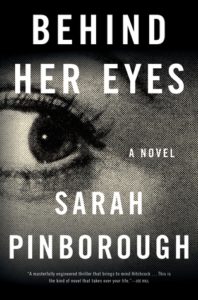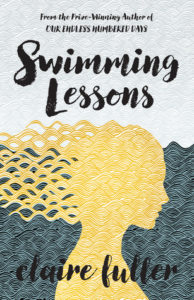Lillian Boxfish Takes a Walk by Kathleen Rooney
Rooney, Kathleen. Lillian Boxfish Takes a Walk
St. Martin’s Press, 2017
ISBN 978–1–250–11332–0
I am old and all I have left is time. I don’t mean time to live; I mean free time. Time to fill. Time to kill until time kills me. I walk and walk and think and think. It gets me out, and it keeps me healthy, and no one on the street seems to mess with me, as they say on the street. All my friends in New York—back when I still had friends, before everyone moved away or died—had mugging stories, but I’ve never had trouble. (p. 61)
 In this novel Kathleen Rooney rejuvenates the well-worn metaphor that life is a journey. As Lillian Boxfish walks around Manhattan, she reminisces about her life, from her career as the country’s highest-paid woman in advertising in the 1930s up to the present. In the process she not only recaps her life but also creates a love letter to New York City in all its historic grandeur.
In this novel Kathleen Rooney rejuvenates the well-worn metaphor that life is a journey. As Lillian Boxfish walks around Manhattan, she reminisces about her life, from her career as the country’s highest-paid woman in advertising in the 1930s up to the present. In the process she not only recaps her life but also creates a love letter to New York City in all its historic grandeur.
On New Year’s Eve, 1984, 85-year-old Lillian Boxfish sets out for her annual dinner at a favorite neighborhood restaurant. But before she leaves she eats nearly an entire package of Oreo cookies (not failing to acknowledge the irony that this former star advertiser has been influenced by contemporary advertising) and isn’t hungry when she arrives. Nevertheless, she stays long enough to chat with the restaurant owner, her long-time friend. When she leaves, she decides that if she walks to Delmonico’s, the exercise will have aroused her hunger by the time she arrives there.
As she walks from midtown to lower Manhattan, Lillian thinks back on the life that brought her here, to the brink of 1985. She begins lightheartedly describing her early life as an aspiring writer who left her family in Washington, D.C., to strike out on her own in New York City. With self-deprecating humor she describes her ascendency in the advertising department at R. H. Macy’s department store and her success as a published poet. But the further she walks, the deeper she digs into her past, finally getting to its most significant events.
When Lillian gets to Delmonico’s she finds out that she can’t get in without a reservation on this, one of the busiest evenings of the year. A young family, overhearing her plead her case to the hostess, invites her to take the extra place at their table caused by a last-minute cancelation. She enjoys talking with the family while awaiting her delectable steak:
We chat about the things New Yorkers chat about … but I am surprised to find, and I think they are too, that our stories emphasize the serendipitous, even the magical. Our tone is that of conspirators, as though we are afraid to be overheard speaking fondly of a city that conventional wisdom declares beyond hope. My long walks, I discover, have provided a rich reserve of encounters with odd, enthusiastic, decent people; I hadn’t realized that I have these stories until someone asked to hear them. (p. 153)
Lillian may be surprised at her magical stories, but readers aren’t. We see some of those stories in the making as Lillian interacts with people she encounters along her walk: a pregnant woman waiting while her partner parks the car before entering St. Vincent’s Hospital, a young man working the late shift at his family’s bodega, the limo driver who tries hard to give her a ride, three teenagers intent on stealing her mink coat. These encounters demonstrate that Lillian’s true gift is to encourage people to tell their stories, to notice details and look beneath surface appearances, to find joy in understanding people in their individuality. Lillian goes out this New Year’s Eve in search of dinner, but she also allows New York City to feed her creative soul.
Lillian Boxfish is a delightful character. I’m glad I met her, and I’ll take to heart her lessons of how to find goodness and joy in the world.
© 2017 by Mary Daniels Brown
Behind Her Eyes by Sarah Pinborough
Pinborough, Sarah. Behind Her Eyes
Flatiron Books, 2017
ISBN 978–1–250–11117–3
 Do you remember all the hype that surrounded the movie The Sixth Sense? Don’t give the surprise ending away, all the ads and reviews exhorted, and for the most part people didn’t. The same thing happened again with the release of Gillian Flynn’s novel Gone Girl and, again, most people complied.
Do you remember all the hype that surrounded the movie The Sixth Sense? Don’t give the surprise ending away, all the ads and reviews exhorted, and for the most part people didn’t. The same thing happened again with the release of Gillian Flynn’s novel Gone Girl and, again, most people complied.
And now it’s happening again with Sarah Pinborough’s novel Behind Her Eyes. The wording is a bit different, but the message is the same. From the front flap of the dust jacket:
And if you think you know where this story is going, thing again, because Behind Her Eyes is like no other book you’ve read before.
And from the back flap:
Sarah Pinborough has written a novel that takes the modern-day love triangle and not only turns it on its head but completely reinvents it in a way that will leave readers reeling.
I’m willing to go along with the common agreement that book reviews should not contain revelations that will spoil the reading experience for others, even though that dictum restricts what a reviewer can say. I read a lot of mystery and suspense novels, and it’s usually easy to write a review without giving away too much.
But in the case of Behind Her Eyes, that restriction leaves little else to say about the book other than that it deals with a love triangle. I can tell you that I read the book slowly and carefully, and I did figure out the ending a little bit before it happened. But the important question is not so much “What happens?” as “What do I, as a reader, want to do with what happens?” I will tell you that if I had known about the ending beforehand, I wouldn’t have read the novel—not because of the spoiled surprise, but because of what that surprise means to me in a literary sense.
That’s a cryptic statement, I know. Feel free to get in touch with me for a real explanation if you like, but only AFTER you’ve finished the book.
© 2017 by Mary Daniels Brown
Swimming Lessons by Claire Fuller
Fuller, Claire. Swimming Lessons
Tin House Books, 2017
ISBN 978–1941040515
I never meant for this to be my life. (p. 328)
 Gil Coleman’s wife, Ingrid, has been missing for exactly 11 years and 10 months when he sees her out of the bookshop window. At least he thinks he sees her. The old man sets off in pursuit but suffers a nasty fall that requires a lengthy convalescence.
Gil Coleman’s wife, Ingrid, has been missing for exactly 11 years and 10 months when he sees her out of the bookshop window. At least he thinks he sees her. The old man sets off in pursuit but suffers a nasty fall that requires a lengthy convalescence.
Ingrid, who disappeared one day after a swim in the ocean, has been presumed dead, even though her body was never found. Since Ingrid’s disappearance Gil, well known author of the racy novel A Man of Pleasure, has been searching through his vast literary collection in search of the letters his wife wrote and hid in his books during the month before she vanished.
In her letters Ingrid recounts the story of her life with Gil: her initial encounters with the charming college writing instructor in 1976, the summer romance and ensuing pregnancy and marriage that forced her to leave university shortly before graduating, her fears and disillusionment about motherhood, her thwarted dreams, and the deterioration of their marriage.
The novel’s present time is 2004, when Gil and Ingrid’s two daughters arrive to care for him during his convalescence. Nan, 15 when her mother disappeared, took over mothering Flora, who was not quite 10. Now Nan assumes the main responsibility of caring for Gil while Flora, an art student who never accepted her mother’s death, immerses herself in memories, trying to imagine why her mother left and where she has gone.
The novel unfolds in chapters that alternate between the present and Ingrid’s letters, written in 1992. She starts writing to put down
all the things I haven’t been able to say in person—the truth about our marriage from the beginning. I’m sure I’ll write things you’ll claim I imagined, dreamed, made up; but this is how I see it. This, here, is my truth. (p. 17)
A minor but important character in the novel is Gil’s friend, Jonathan. His function is to attest to the reader about the veracity of Ingrid’s narrative. Without Jonathan to confirm it, Ingrid’s story would seem less credible.
Ingrid’s truth comprises all the big issues of a woman’s life: love, trust, marriage, motherhood, friendship, betrayal, independence, hopes, ambitions, responsibilities. I finished this book wondering how all these issues will play out in the lives of Ingrid’s two daughters. In the letters to Gil Ingrid stresses that when he finishes reading them, he must destroy them so that the girls will never see them. Her intention is to prevent them from learning the painful truth about their father, but they might have benefitted more from the opportunity to learn the truth about their mother.
© 2017 by Mary Daniels Brown

